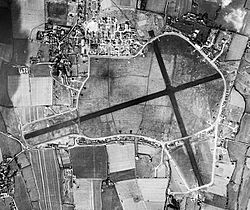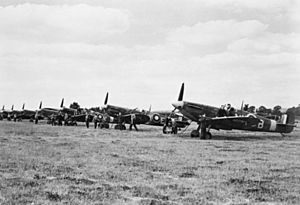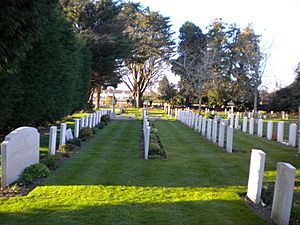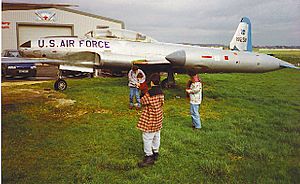RAF Tangmere facts for kids
Quick facts for kids RAF Tangmere
|
|||||||||
|---|---|---|---|---|---|---|---|---|---|
| Tangmere, West Sussex in England | |||||||||

Aerial photograph of Tangmere airfield, 10 February 1944
|
|||||||||

Station badge
|
|||||||||
|
Location in West Sussex
|
|||||||||
| Coordinates | 50°50′45″N 000°42′23″W / 50.84583°N 0.70639°W | ||||||||
| Grid reference | SU910060 | ||||||||
| Type | Royal Air Force Sector Station | ||||||||
| Code | RN | ||||||||
| Site information | |||||||||
| Owner | Ministry of Defence | ||||||||
| Operator | Royal Air Force 1919-20 1925- Royal Flying Corps 1917 U.S. Signal Corps 1918-1919 Fleet Air Arm |
||||||||
| Controlled by | RAF Fighter Command * No. 11 Group RAF RAF Second Tactical Air Force *No. 84 Group RAF RAF Signals Command 1958- |
||||||||
| Open to the public |
Yes | ||||||||
| Site history | |||||||||
| Built | 25 September 1917 & 1927-30 | ||||||||
| In use | 1917-20 1925 - October 16, 1970 |
||||||||
| Battles/wars | First World War European theatre of World War II |
||||||||
| Events | Battle of Britain | ||||||||
| Garrison information | |||||||||
| Past commanders |
C. W. Hill | ||||||||
| Airfield information | |||||||||
| Elevation | 15 metres (49 ft) AMSL | ||||||||
|
|||||||||
Royal Air Force Tangmere or RAF Tangmere was a famous Royal Air Force station located in Tangmere, England. It played a very important part in the Battle of Britain during the Second World War.
This air base was one of several near Chichester, West Sussex. Famous pilots like Wing Commander Douglas Bader, who was a flying ace, and Johnnie Johnson were stationed here in 1941.
Contents
History of RAF Tangmere
First World War Beginnings
The airfield at Tangmere started in 1917. It was first used by the Royal Flying Corps as a place to train pilots. In 1918, it was taken over by the Aviation Section, U.S. Signal Corps (USSC) for training American pilots. After the First World War ended in November 1918, the airfield was closed down in 1919.
Many different squadrons used Tangmere for training during this time, including No. 14 Squadron RAF, No. 32 Squadron RAF, and No. 40 Squadron RAF.
Between the World Wars
In 1925, RAF Tangmere reopened. It became fully operational in 1926 with No. 43 Squadron RAF, which flew biplane Gloster Gamecock aircraft.
As the threat of another war grew in the late 1930s, the fighter aircraft at Tangmere became much faster. Planes like the Hawker Fury, Gloster Gladiator, and Hawker Hurricane were all used here.
In 1934, Squadron Leader C W Hill, a famous First World War prisoner-of-war escaper, commanded No. 1 Fighter Squadron at Tangmere. Two years later, he became the station commander.
RAF Tangmere in World War II
In 1939, the airfield was made bigger to help defend the south coast of England from attacks by the German air force, the Luftwaffe. To do this, Tangmere's only hotel and some houses had to be knocked down. Most of the houses in the village were taken over by the RAF, and only a few families were allowed to stay. The village didn't become a normal civilian community again until 1966.
In August 1940, the Battle of Britain began. The first squadron of Supermarine Spitfires, No. 602 Squadron RAF, was based at Westhampnett, a nearby satellite airfield. By this time, most villagers had moved away, and many new RAF buildings had been built.
The worst enemy attack on the station happened on August 16, 1940. Hundreds of German Junkers Ju 87 (Stuka) dive bombers and fighters attacked Tangmere. Many buildings and aircraft on the ground were badly damaged. Sadly, 14 ground staff and six civilians were killed. Despite this, the station was quickly repaired and put back into full operation.
Throughout the war, RAF Tangmere was used by the Royal Air Force Special Duty Service. 161 (Special Duty) Squadron used the base for secret missions. They would fly Westland Lysander planes to drop off and pick up agents in occupied Europe. The SOE, a secret British organization, used Tangmere Cottage, across from the base's main entrance, to house their agents. Today, the cottage has a special plaque remembering its secret past.
Later in the war, as the RAF started to attack more, Group Captain Douglas Bader commanded the Tangmere wing of Fighter Command. He was a famous fighter ace who had lost both his legs. Today, there's a plaque for him outside a building that used to be a pub called the Bader Arms. 616 Squadron, which included Johnnie Johnson and Hugh Dundas, arrived at Tangmere in early 1941. Johnnie Johnson became the highest-scoring Western Allied fighter ace against the Luftwaffe.
For D-Day, the RAF created special Airfield Headquarters units. These units controlled many squadrons for attacks into mainland Europe. Many different squadrons from various countries, including Canada, Norway, and Czechoslovakia, were based at Tangmere during this time.
Many of those who died at the base, both Allied and German, are buried in the cemetery at St Andrews Church, Tangmere. The Commonwealth War Graves Commission looks after these graves today. American RAF pilot Billy Fiske, who died at Tangmere in 1940, was one of the first American airmen to die in the Second World War.
Many squadrons were based at Tangmere for defense from 1939-1941, including No. 17 Squadron RAF and No. 43 Squadron RAF. From 1941-1945, offensive squadrons like No. 41 Squadron RAF and No. 198 Squadron RAF flew from Tangmere.
After the War
After the Second World War, the Central Fighter Establishment moved to Tangmere in 1945. The station was even renamed CFE Tangmere for a while. The RAF High Speed Flight was restarted here in 1946.
In September 1946, Group Captain Edward "Teddy" Mortlock Donaldson set a new world air speed record of 616 mph (991 km/h) in a Gloster Meteor F.4 jet. He was later buried in St Andrews Church. In September 1953, Squadron Leader Neville Duke broke the record again, flying a special Hawker Hunter prototype at 727.63 mph (1,170 km/h).
Many squadrons continued to operate from Tangmere after the war, flying planes like the de Havilland Mosquito and the Gloster Meteor.
On June 1, 1950, a Gloster Meteor flying near Portsmouth reported seeing a UFO at 20,000 ft. Radar at RAF Wartling also saw it. This event was called Britain's first flying saucer sighting!
In the late 1950s, flying activities at Tangmere were reduced. The base then focused on ground radar calibration under RAF Signals Command.
In 1960, the station was given the "freedom of the City of Chichester". This was a special honor marked by a parade through the town.
The last flying units left Tangmere in 1963-1964. However, the station was still used for a few more years. In 1968, Prince Charles took his very first flying lesson at Tangmere. The station finally closed on October 16, 1970. A single Spitfire flew over the airfield as the RAF flag was lowered for the last time.
What is RAF Tangmere Like Today?
After the RAF station closed, some of the land around the runways was turned back into farmland. Today, Tangmere Airfield Nurseries has large glasshouses where they grow peppers and aubergines.
Until 1983, about 37 acres of old barracks, offices, and workshops were left empty. Then, a company bought the land, and houses were built around the airfield. Most of the old RAF buildings were knocked down. However, the officers' living quarters were kept and turned into homes. Two original RAF buildings still stand: the Control Tower, which is a listed building, and one of the 'H Block' accommodation buildings.
Most of the airfield is now used for farming. Since 1979, the runways have slowly been removed, turning the land back into large fields. In 2016, the last part of the concrete apron and three large aircraft hangars were removed. Houses have now been built there on a street called Hangar Drive.
The old control tower is now part of a farm. It is bricked up and partly covered by plants. It became a grade II listed building in 2011, meaning it's protected because of its history. A group called Tangmere Tower Community Interest Company is working to restore the control tower. They are working with the local Aviation Museum and other groups to save this important piece of history.
Tangmere Military Aviation Museum
The Tangmere Military Aviation Museum was started by a group of people who used to be in the military. It has a copy of a Supermarine Spitfire and a Hawker Hurricane. It also has many real aircraft, including Neville Duke's speed record Hawker Hunter. You can also see the 'Star' Meteor flown by Teddy Donaldson when he broke the world air speed record in 1946, flying faster than 1,000 km/h!
Locomotive "Tangmere"
Some steam locomotives were named after famous Battle of Britain squadrons, stations, or commanders. One of these, still working today, is called "Tangmere" (number 34067).
See also






